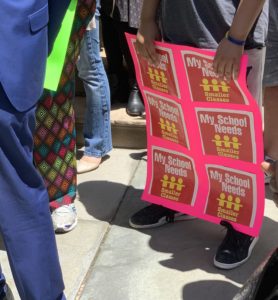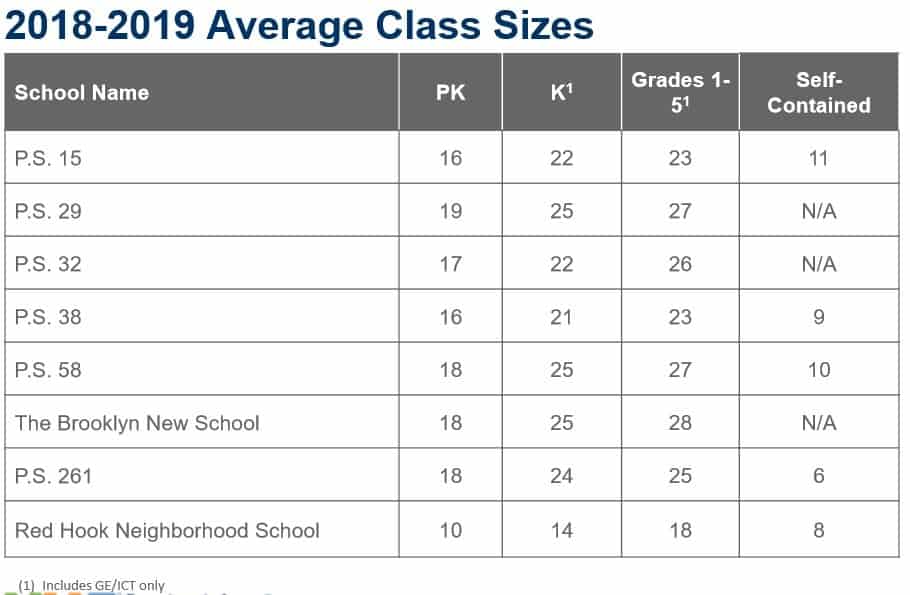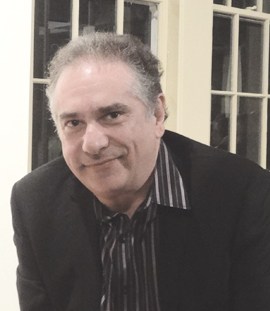School may be out for the summer, but that doesn’t mean it still isn’t on people’s minds. A large group of parents, students, teachers, advocates and elected officials stood on the steps of City Hall on June 11, demanding smaller class sizes for an hour. They also urged the Department of Education (DOE) and Mayor Bill de Blasio to allocate specific funding in next year’s budget towards reducing class size in New York City public schools.

“The mayor and the chancellor talk a lot about bringing equity and excellence to our schools and some the moves they are making may bring us closer to that goal. But there’s a huge gaping hole in their agenda and that relates to class size,” said Executive Director of Class Size Matters Leonie Haimson, who’s been working on this issue for 20 years. “This fall, more than 330,000 kids were crammed into classes of 30 or more. Our class sizes are 10 to 30 percent larger on average than in the rest of the state. Classes this large are neither equitable nor excellent, especially as studies show that students of color gain twice the benefit in smaller classes when class sizes are reduced.”
Though the state’s highest court concluded in 2003 that City public school classes were too large to provide students with their constitutional right to a sound basic education, class sizes have increased, especially in the early grades. Between 2007 and 2016, for example, the number of students in classes of 30 or more in grades 1 through 3 increased by 4,000 percent, as per Class Size Matters. Haimson attributes this to City budget cuts that began around the Great Recession (and not fully recovering from that) and increased overcrowding in elementary schools. She told us solutions to the problem, though probably expensive to execute, are hiring more teachers and having more classrooms available.
District 15, Specifically
There are 60 schools in District 15, whose neighborhoods include Boerum Hill, Carroll Gardens, Cobble Hill, Fort Greene, Gowanus, Kensington, Park Slope, Sunset Park and Red Hook.
The following chart is from the DOE Office of District Planning’s Planning for Additional Elementary School Seats presentation on May 20. Class Size Matters has advocated for no more than 20 in K through 3, 23 in 4 through 8 and 25 in high school – numbers that, Haimson says, the City originally promised to achieve back in 2007.

Twenty-two of 26 schools serving elementary school students in District 15 were over-utilized, according to the district’s 2019-2020 Planning Presentation from the DOE Office of District Planning last year. PS 32 was the most over-utilized building at 181 percent, based on 2016-2017 Blue Book records. (Construction on a 436-seat addition at PS 32, which replaced previous TCU capacity and will help address elementary school overcrowding in the area, is scheduled for completion in 2020 to 2021.) PS 15, Cobble Hill School of American Studies and PS 373, which have between 150 and 299 seats, were under-utilized at 72%.
Lina Rosario, a sixth grader at MS 839, went to City Hall and spoke about her experiences from learning in an overcrowded class of 33 students. She said she and other students often sought out extra help from the teacher during their lunch periods, but she still sometimes didn’t get the best math grades afterward.
“If there’s another student across the room who needs help and there’s another student that’s misbehaving, the teacher can’t get to both of them, so the class is sorta wild every single time,” Rosario explained at the podium. “Our mayor has to notice that us students are struggling in math and most classes that matter because we don’t get enough help due to all the students in our class.”
Shino Tanikawa, co-chair of the Educational Council Consortium (which represents the parent-led Community District and Citywide Councils), also noted that the class size reduction has remained parents’ priorities on the DOE’s annual Learning Environment Survey. Twenty-one percent of parents requested smaller class sizes, according to both the 2016 and 2017 surveys’ results. The only matter that surpassed smaller class sizes both years was wanting stronger enrichment programs like afterschool programs, clubs and teams.
Local Pols and Group Leaders Sound Off
“School overcrowding and large class sizes have been a known problem in our school system for far too long. This is a basic equity issue for our students – classes that are too large make it impossible for teachers to provide differentiated instruction and individualized attention, which children need to do their best,” said former teacher and Council Education Chair Mark Treyger. “I urge Mayor de Blasio and Chancellor Carranza to meet the mandates outlined under the C4E [Contract for Excellence] decision, and make a serious commitment to reducing class sizes.”
The Universal Pre-Kindergarten program has provided free, full-day schooling to four-year-olds since 2014. However, once these students move on to Kindergarten and beyond, the problems become larger classes in limited spaces.
“The biggest risk to our Pre-K students occurs when they enter grades K through 3, where too often they’re expected to learn in classes of 30 or more. Yet the DOE insists on pushing more and more Pre-K and now 3-K kids into elementary schools that are already overcrowded, which causes our CBO [community-based organization] enrollment to drop and threatens our viability,” said Brooklyn Pre-K director Alice Mulligan, who spoke on behalf of CBOs for Equity.
Similarly, Naila Rosario, president of NYC Kids PAC, mentioned kids need more help once they turn five, in addition to more feedback and support from their teachers – which she and others believe is impossible, given the current conditions.
Other elected officials who spoke and gave support for class size reduction included Manhattan Borough President Gale Brewer, Council Majority Leader Laurie Cumbo and Council Members Adrienne Adams, Inez Barron, Barry Grodenchik and Brad Lander.
Top photo of Lina Rosario, speaking at the podium, taken by DeGregorio
Author
-

George Fiala has worked in radio, newspapers and direct marketing his whole life, except for when he was a vendor at Shea Stadium, pizza and cheesesteak maker in Lancaster, PA, and an occasional comic book dealer. He studied English and drinking in college, international relations at the New School, and in his spare time plays drums and fixes pinball machines.
View all posts
George Fiala has worked in radio, newspapers and direct marketing his whole life, except for when he was a vendor at Shea Stadium, pizza and cheesesteak maker in Lancaster, PA, and an occasional comic book dealer. He studied English and drinking in college, international relations at the New School, and in his spare time plays drums and fixes pinball machines.










